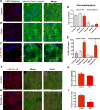Non-Endoplasmic Reticulum-Based Calr (Calreticulin) Can Coordinate Heterocellular Calcium Signaling and Vascular Function
- PMID: 29122814
- PMCID: PMC5746467
- DOI: 10.1161/ATVBAHA.117.309886
Non-Endoplasmic Reticulum-Based Calr (Calreticulin) Can Coordinate Heterocellular Calcium Signaling and Vascular Function
Abstract
Objective: In resistance arteries, endothelial cell (EC) extensions can make contact with smooth muscle cells, forming myoendothelial junction at holes in the internal elastic lamina (HIEL). At these HIEL, calcium signaling is tightly regulated. Because Calr (calreticulin) can buffer ≈50% of endoplasmic reticulum calcium and is expressed throughout IEL holes in small arteries, the only place where myoendothelial junctions form, we investigated the effect of EC-specific Calr deletion on calcium signaling and vascular function.
Approach and results: We found Calr expressed in nearly every IEL hole in third-order mesenteric arteries, but not other ER markers. Because of this, we generated an EC-specific, tamoxifen inducible, Calr knockout mouse (EC Calr Δ/Δ). Using this mouse, we tested third-order mesenteric arteries for changes in calcium events at HIEL and vascular reactivity after application of CCh (carbachol) or PE (phenylephrine). We found that arteries from EC Calr Δ/Δ mice stimulated with CCh had unchanged activity of calcium signals and vasodilation; however, the same arteries were unable to increase calcium events at HIEL in response to PE. This resulted in significantly increased vasoconstriction to PE, presumably because of inhibited negative feedback. In line with these observations, the EC Calr Δ/Δ had increased blood pressure. Comparison of ER calcium in arteries and use of an ER-specific GCaMP indicator in vitro revealed no observable difference in ER calcium with Calr knockout. Using selective detergent permeabilization of the artery and inhibition of Calr translocation, we found that the observed Calr at HIEL may not be within the ER.
Conclusions: Our data suggest that Calr specifically at HIEL may act in a non-ER dependent manner to regulate arteriolar heterocellular communication and blood pressure.
Keywords: blood pressure; calcium signaling; calreticulin; endoplasmic reticulum; endothelial cells; myoendothelial junction.
© 2017 American Heart Association, Inc.
Conflict of interest statement
Disclosures: None of the authors declare any conflicts of interest with the work in this manuscript.
Figures






Similar articles
-
Endothelial calreticulin deletion impairs endothelial function in aged mice.Am J Physiol Heart Circ Physiol. 2020 May 1;318(5):H1041-H1048. doi: 10.1152/ajpheart.00586.2019. Epub 2020 Mar 20. Am J Physiol Heart Circ Physiol. 2020. PMID: 32196361 Free PMC article.
-
Advanced age decreases local calcium signaling in endothelium of mouse mesenteric arteries in vivo.Am J Physiol Heart Circ Physiol. 2016 May 1;310(9):H1091-6. doi: 10.1152/ajpheart.00038.2016. Epub 2016 Mar 4. Am J Physiol Heart Circ Physiol. 2016. PMID: 26945073 Free PMC article.
-
Two functionally distinct pools of eNOS in endothelium are facilitated by myoendothelial junction lipid composition.Biochim Biophys Acta. 2016 Jul;1861(7):671-9. doi: 10.1016/j.bbalip.2016.04.014. Epub 2016 Apr 19. Biochim Biophys Acta. 2016. PMID: 27106139 Free PMC article.
-
What's where and why at a vascular myoendothelial microdomain signalling complex.Clin Exp Pharmacol Physiol. 2009 Jan;36(1):67-76. doi: 10.1111/j.1440-1681.2008.05076.x. Epub 2008 Oct 31. Clin Exp Pharmacol Physiol. 2009. PMID: 19018806 Review.
-
Perivascular innervation: a multiplicity of roles in vasomotor control and myoendothelial signaling.Microcirculation. 2013 Apr;20(3):217-38. doi: 10.1111/micc.12035. Microcirculation. 2013. PMID: 23289720 Free PMC article. Review.
Cited by
-
Cellular crosstalk in organotypic vasculature: mechanisms of diabetic cardiorenal complications and SGLT2i responses.Cardiovasc Diabetol. 2025 Feb 26;24(1):90. doi: 10.1186/s12933-025-02655-2. Cardiovasc Diabetol. 2025. PMID: 40012066 Free PMC article.
-
The Calcium Signaling Mechanisms in Arterial Smooth Muscle and Endothelial Cells.Compr Physiol. 2021 Apr 1;11(2):1831-1869. doi: 10.1002/cphy.c200030. Compr Physiol. 2021. PMID: 33792900 Free PMC article.
-
Obesity-Induced Coronary Microvascular Disease Is Prevented by iNOS Deletion and Reversed by iNOS Inhibition.JACC Basic Transl Sci. 2023 Feb 1;8(5):501-514. doi: 10.1016/j.jacbts.2022.11.005. eCollection 2023 May. JACC Basic Transl Sci. 2023. PMID: 37325396 Free PMC article.
-
Polarized Proteins in Endothelium and Their Contribution to Function.J Vasc Res. 2021;58(2):65-91. doi: 10.1159/000512618. Epub 2021 Jan 27. J Vasc Res. 2021. PMID: 33503620 Free PMC article. Review.
-
Comprehensive Analysis of Endoplasmic Reticulum Stress in Intracranial Aneurysm.Front Cell Neurosci. 2022 Apr 6;16:865005. doi: 10.3389/fncel.2022.865005. eCollection 2022. Front Cell Neurosci. 2022. PMID: 35465608 Free PMC article.
References
-
- Coffman TM. Under pressure: the search for the essential mechanisms of hypertension. Nat Med. 2011;17:1402–9. - PubMed
-
- Oparil S, Zaman MA, Calhoun DA. Pathogenesis of hypertension. Ann Intern Med. 2003;139:761–76. - PubMed
-
- Levy BI, Ambrosio G, Pries AR, Struijker-Boudier HA. Microcirculation in hypertension: a new target for treatment? Circulation. 2001;104:735–40. - PubMed
Publication types
MeSH terms
Substances
Grants and funding
LinkOut - more resources
Full Text Sources
Other Literature Sources
Molecular Biology Databases
Research Materials
Miscellaneous

